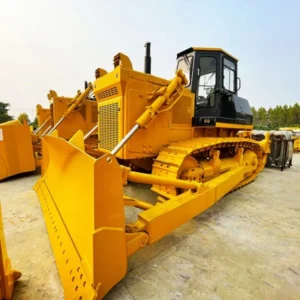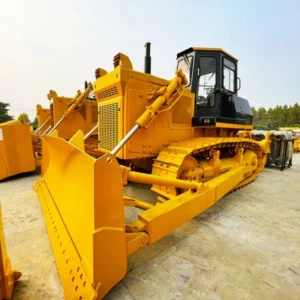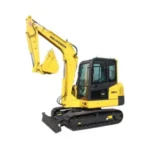معرفی

In the realm of construction, bulldozers play a pivotal role in shaping landscapes and preparing sites for further development. However, the environmental impact of using a bulldozer cannot be overlooked. This blog explores various aspects of how bulldozers affect the environment, ranging from their emissions to their land disturbance capabilities.
The Role of بولدوزرها in Construction
Bulldozers are essential heavy equipment machines used in construction for pushing large quantities of earth, debris, or other materials. Their robust design and powerful engines enable them to perform tasks such as leveling, grading, and clearing land efficiently. These machines are indispensable in creating level surfaces for building foundations, roads, and other infrastructure projects.
Environmental Impact of بولدوزرها
Emissions and Air Quality
One of the most significant environmental concerns associated with a bulldozers is the emissions produced by their diesel engines. These emissions include particulate matter (PM), nitrogen oxides (NOx), and hydrocarbons. Diesel engines, especially older models, emit substantial amounts of these pollutants during operation. Particulate matter can cause respiratory problems and cardiovascular diseases, while nitrogen oxides contribute to smog formation and acid rain. To mitigate these impacts, newer a bulldozer models often come equipped with advanced emission control technologies, such as diesel particulate filters and selective catalytic reduction systems.
Soil Disturbance and Erosion
The operation of bulldozers can lead to significant soil disturbance, which in turn increases the risks of soil erosion. When a bulldozers clear land or grade surfaces, they disrupt the natural soil structure and expose bare soil to wind and water erosion. Erosion can result in sedimentation in nearby water bodies, leading to water quality degradation and habitat destruction for aquatic species. To minimize soil disturbance, construction projects often implement erosion control measures such as silt fences, sediment basins, and revegetation programs.
Habitat Destruction
Bulldozers are often used to clear large areas of vegetation to make way for construction activities. This habitat destruction can have severe consequences for local wildlife populations and ecosystems. By removing vegetation, bulldozers disrupt habitats and fragment landscapes, making it difficult for wildlife to find food, shelter, and breeding grounds. Conservation efforts may include habitat restoration projects and the preservation of green spaces to mitigate the impact of a bulldozer operations on biodiversity.
Case Studies: Environmental Impact Assessments
Construction Site A: Urban Development Project
During a recent urban development project, bulldozers were used extensively to clear land and prepare building sites. Environmental impact assessments revealed several key findings:
| Aspect of Impact | Findings |
|---|---|
| Air Quality | Elevated levels of particulate matter near construction areas |
| Soil Erosion | Increased sedimentation observed in nearby water bodies |
| Wildlife Displacement | Significant reduction in bird and small mammal populations |
Construction Site B: Rural Infrastructure Expansion
In another case study involving rural infrastructure expansion, bulldozers were employed for road construction and land clearing:
| Aspect of Impact | Findings |
|---|---|
| Air Quality | Moderate levels of nitrogen oxide emissions during heavy equipment use |
| Soil Disturbance | Compacted soil observed in areas with frequent a bulldozer activity |
| Habitat Fragmentation | Fragmentation of forested areas affecting larger mammal species |
Mitigation Strategies

To mitigate the environmental impact of using a bulldozers in construction, several strategies can be employed:
- Use of Cleaner Engines: Investing in a bulldozers with newer, more efficient engines can significantly reduce emissions of particulate matter and nitrogen oxides.
- Erosion Control Measures: Implementing erosion control techniques such as sediment traps, vegetative buffers, and erosion blankets can help minimize soil disturbance and prevent sedimentation in water bodies.
- Habitat Conservation: Developing habitat conservation plans and conducting environmental assessments before construction can help identify and protect sensitive habitats and wildlife species.
نتیجه
While بولدوزرها are indispensable in modern construction for their ability to perform heavy earthmoving tasks efficiently, their environmental impact requires careful consideration and mitigation efforts. By adopting technological advancements and best practices in construction management, such as emissions controls and erosion prevention measures, construction companies can reduce the negative effects on air quality, soil integrity, and wildlife habitats.
سوالات متداول
Q:How do بولدوزرها contribute to air pollution?
A:Bulldozers contribute to air pollution primarily through the emissions from their diesel engines, which release particulate matter and nitrogen oxides into the atmosphere.
Q:What are some alternative methods to reduce soil disturbance?
A:To minimize soil disturbance during construction, alternative methods include using bulldozers with wider tracks to distribute weight more evenly and employing techniques like GPS-guided grading to reduce the need for extensive grading.
Q:Can بولدوزرها be used sustainably?
A:Yes, with proper planning, technology integration, and adherence to environmental regulations, bulldozers can be used sustainably in construction projects. Strategies such as incorporating low-impact development techniques and employing efficient equipment can help minimize their environmental footprint.






-150x150.webp)
